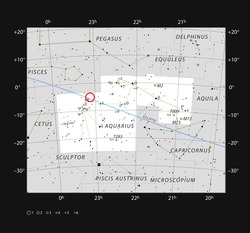TRAPPIST-1
Astronomers first discovered three Earth-sized planets orbiting the dwarf star in 2015. A team led by Michaël Gillon at the University of Liège in Belgium detected the planets using transit photometry with the Transiting Planets and Planetesimals Small Telescope (TRAPPIST) at the La Silla Observatory in Chile.On 22 February 2017, astronomers announced four additional exoplanets around TRAPPIST-1.This work used the NASA Spitzer Space Telescope and the Very Large Telescope at Paranal, among others, and brought the total number of planets to seven, of which three are considered to be within its habitable zone;conceivably, the others also could be habitable as they may possess liquid water somewhere on their surface.
In February 2017, astronomers announced
that the planetary system of this star is composed of seven
temperate terrestrial planets, of which five (b, c, e, f and g)
are similar in size to Earth, and two (d and h) are
intermediate in size between Mars (which has a diameter
about half that of Earth) and Earth. Three (e, f and g) orbit in
the habitable zone. The total mass of the six inner planets is
approximately 0.02% the mass of TRAPPIST-1, a fraction similar to
that for the Galilean satellites, a fact which is suggestive of
a similar formation history.
That TRAPPIST-1 planetary system is located within the red circle in the constellation Aquarius (the Water Carrier).
The TRAPPIST-1 planetary system, based on data about diameters, masses, and distances from the host star (artist's impression).
The TRAPPIST-1 planetary system compared with similar solar system bodies for scale.
From Wikipedia, the free encyclopedia






No comments:
Post a Comment
Note: Only a member of this blog may post a comment.